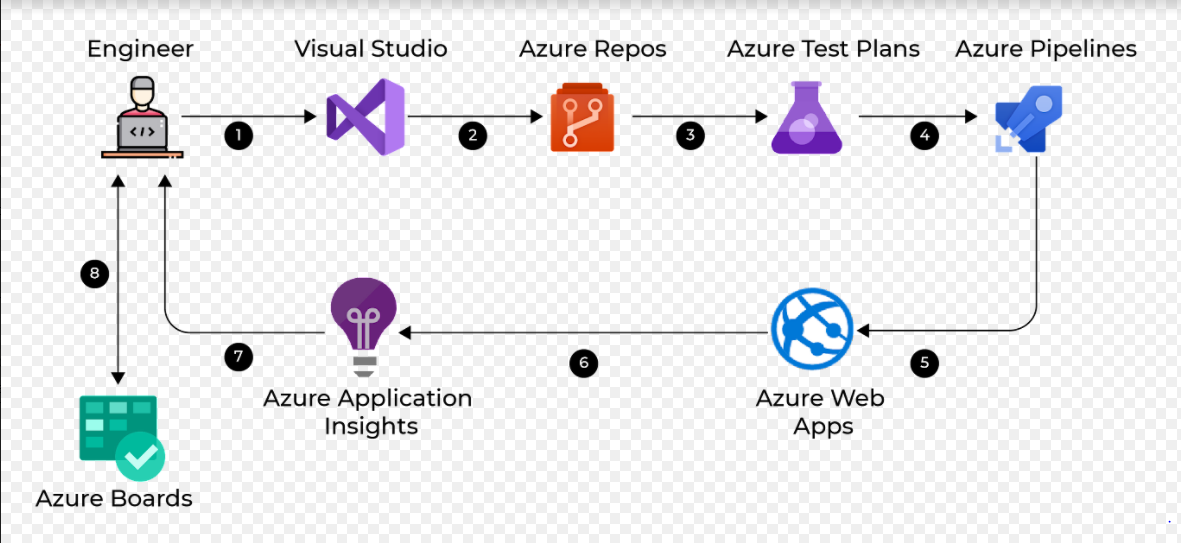Security Considerations For Your 2022 CI/CD Services Can Find Their Peace In Azure DevOps

Audio : Listen to This Blog.
2022 finds itself right at the center of all the action that fast-moving modern technology is going through, and the developers are expected to keep up. Customers cannot allow delay in product releases due to inconsistency and excessive manual labour limitations. Therefore, the main motive of Continuous Integration (CI) and Continuous Delivery (CD) is to help developers to release the software at faster speed without compromising on the quality. Also, we know that Azure Service is a reliably managed web app development, deployment, and scaling platform that can help the DevOps teams with their modern product engineering needs. Moreover, Azure DevOps has the right security features needed by the CI/CD pipeline to win over the cyber threats the world faced in the beginning of this decade. Through this blog, let’s take a deeper look at each of the modernization and security aspects of Azure DevOps and its implications for your CI/CD processes and digital transformation ambitions.
CI/CD Solutions: The Journey of Automation
Continuous Integration (CI) aids in the integration and sharing of code in mainline repositories. CI-triggered automated build-and-test stages ensure that code changes merged into the repository are trustworthy. Post that, Continuous Delivery (CD) picks up, and helps with the deployment of all the code changes automatically to a production environment. This kind of testing saves time for developers and reduces human mistake. Therefore, CI/CD together make the whole DevOps engine functioning and at par with the customer’s digital needs. It is imperative that CICD is seamless as it is automated to support the development and operations teams.
CI/CD Pipeline
CI/CD services employs a set of procedures that must be followed to deliver a new version of the application. Mostly used with DevOps, CI/CD pipelines are intended for businesses that want to improve their applications on a regular basis and require a dependable delivery process. CICD DevOps altered the way software developers and testers approach software releases. Below are the CICD pipeline stages;
- Source stage: This stage is responsible for keeping an eye on the version control system for changes and triggering events like code compilation and testing.
- Build Stage: Here the source code and its dependencies are combined, when generating a runnable instance to the end-user programme.
- Test Stage: This is the validation stage of the code and its behavior. This stage prevents the bugs from reaching the end user.
- Deployment Stage: Here the tested code is deployed to the production environment.
Why there is a need for CI/CD Modernization?
Shorter Code: Continuous integration and continuous delivery have the technical advantage of allowing you to integrate small portions of code at a time. Because of the continuous integration, developers can use shorter codes instead of larger bulks.
Improved Test Reliability: Codes are promptly tested with CICD’s automated testing capabilities. This allows programmers to quickly identify faults and make appropriate modifications.
Speedy Delivery: The problems are frequently corrected before other feature pressures develop the non-critical defect backlogs are lower. This leads to an increase in release rate. Frequent releases, on the other hand, are only conceivable if the code is produced in a constantly moving system.
Fault Identification and Isolation: One of the most widely touted benefits of CI/CD is its ability to identify the fundamental cause of a problem and then pinpoint its specific location. Fault isolation is a process that helps to restrict the negative consequences of an error by pinpointing the source and location of the problem.
Faster Mean Time To Resolution (MTTR): Because of the lower code changes and faster fault isolation, the mean time to resolution (MTTR) is shorter.
Customer Satisfaction: Bug detection in development phase leads to faster release. Customer satisfaction will be increased if your system receives bug-free and timely updates.
There are multiple ways in which the CI/CD pipeline can be modernized for 2022. One of the most reliable ones from performance and security perspective is what we will now delve into for further discussion.
Azure DevOps Deployment Strategy
Microsoft Azure DevOps is a popular solution for automating code builds, automation tests, and deployment to the appropriate environment. The Azure DevOps CI/CD pipeline streamlines the application development process by facilitating continuous integration and continuous delivery (CI/CD). Azure Repos can keep track of a central repository, while Azure Pipelines can keep track of development and release pipelines for a project.
The following is a cloud-based Azure DevOps CI/CD pipeline example
- A developer modifies the source code or creates a new code of an application.
- In Azure Repos, the application code, including the web.config file, is committed to the source code repository.
- Continuous integration (CI) uses Azure Test Plans to trigger application build and unit tests.
- Continuous deployment of properly tested and built artifacts to the needed environments with the necessary dependencies and environmental variables is then triggered by Azure Pipelines.
- The Azure Artifacts service, which serves as a universal repository, stores artifacts.
- Developers monitor and manage data on health, performance, and usage.
- Using Azure Boards, backlog information is utilized to prioritize new features and issue solutions.

For example: Configuring Java CI/CD using Jenkins and Azure Web Apps
2021 saw a barrage of cyberattacks especially Ransomware and networking attacks. Therefore, moving further with CI/CD with all its indispensable benefits, it is necessary that we take into account, the security considerations. Fortunately, Azure DevOps already has it covered.
- Easy Secret Management: Secrets from an Azure Key Vault can be downloaded into your release using Azure Key Vault tasks. You can then use those secrets as variables in your release specification, eliminating the need to save them in source control.
- Real-time Change Management: To drive configuration changes in your environments, use release variables in your release specifications.
- Variables in a release might be applied to the entire release or a specific environment. While using variables for secret information, make sure the padlock icon is selected.
- End-to-end Monitoring: In your release pipeline, deployment gates should be used. This enables you to use monitoring data in conjunction with external systems to assess if a release should be promoted. Use the approvals functionality when manual intervention in a release pipeline is required.
Conclusion:
CICD services are helpful to avoid risk and build up the development practices. Not only it improves the code quality but also software updates are delivered rapidly and with confidence that there won’t be any more changes introduced. Securing the CI/CD pipelines are important for the organizations. In order to keep the product and operations safe from hackers, security must be baked into the CI/CD pipeline.
